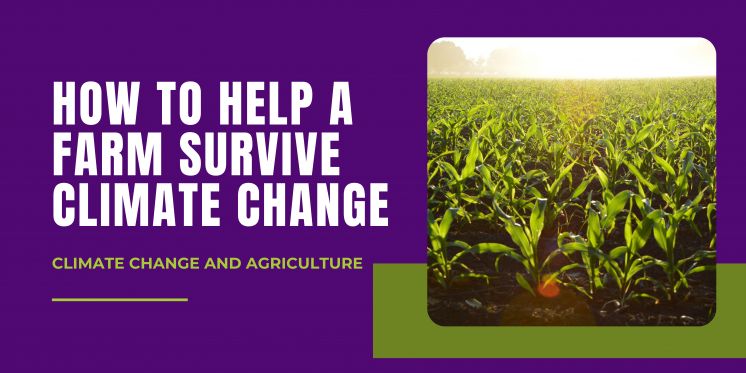More than that, while some farmers are taking it into their own hands with innovative ways of adapting to climate change, most farmers are at the mercy of the weather. There are many factors that come into play when it comes to crops and farming-soil type, irrigation, pests, livestock production, and more. So, here are some tips on how to help a farm survive climate change.
Climate Change and Agriculture
According to the Climate Change Fifth Assessment Report by the University of Cambridge in 2014, food production is expected to decline as a result of climate change, with a decrease in the yields of important crops. And this will occur simultaneously with the rise in agricultural demand, which is expected to climb by around 14% every decade until 2050.
Climate warming is projected to diminish the average production of important grains such as wheat, rice, and maize in temperate zones if no adaptation is made. As a result, freshwater supplies are projected to be put under greater strain and prices and markets are predicted to be volatile, weed and insect damage to crops will grow, and land-based ecosystems and their functions will be significantly damaged.
Overall, agricultural yields have already been reduced by climate-related consequences in certain regions, and this tendency is expected to continue as temperatures continuously increase. Wheat, maize, and rice are among the crops impacted. Climate change is expected to lead to an increase in agricultural commodity price volatility and a decrease in the quality of food.
How to help a farm survive climate change
1. Optimize crop rotation and planting schedules
Improved crop rotation systems, adaptive water management approaches, and more accurate weather predictions are among the most successful, sustainable, and resilient agricultural production strategies. It is possible to boost yields by a median of 3% to 17% by changing the planting date. Using procedures like dry sowing, seedling transplanting, and priming, as well as advancements in technology, early sowing is becoming more and more commonplace.
Further, crop variety and planting schedule optimization is an efficient way to adapt, improving yields by up to 23%. More than that, crop rotation systems can enrich soil health benefits while mitigating climate change. To top that, this technique is valuable for farmers who are attempting to cope with shifting pest and weed pressure, helping them remain productive as climate change gets more severe
2. Reduce soil tilling
For most climate-smart farmers, the soil is treated like a crop. Good soil is one of the world's greatest carbon sinks, boosting the flavor and nutritional value of food cultivated in it. Taking care of the soil may lead to increased greenhouse gas sequestration and better crops. One of the ways farmers can help save their farms amidst climate change is reduced soil tilling.
Tilling soil dries the soil before seeding. Crop yields might be adversely affected if you reside in a dry region. While tilling may remove minerals like nitrogen and fertilizer from the soil, this might reduce its capacity to hold water. As such, reduced soil tilling is advised for farmers to avoid soil erosion and to keep their lands have increased water infiltration.
In addition, farmers, in particular, profit from not having to plow the land, since there is less preparation to be done. There is a significant reduction in fuel use due to a decrease in the use of large agricultural machines. That means lower overall expenses.
3. Use covers for crops
There is a growing consensus that covers for crops may help mitigate the impacts of climate change on agriculture by reducing soil erosion, fixing nitrogen in the atmosphere, reducing nitrogen leaching, and improving soil health. Covers for crops are sown to protect the soil from weeds, improve organic matter and fertility, and avoid erosion and compaction. This increases the soil's water-holding capacity and enables penetration of water more quickly.
More than that, research shows that cover-crop effects on greenhouse-gas fluxes typically mitigate warming by 100-150 grams of carbon per square meter per year. This may be even greater than the effects of reduced soil tilling. Some of the ways you can maximize crop covers in minimizing greenhouse gas fluxes are carbon sequestration in the soil and reduction of fertilizer consumption.
4. Employ innovative irrigation practices
An innovative irrigation practice controls water release so that crops receive only the amount needed. Improving storage and access to irrigation water are just a few of the adaptive water management techniques that can be used. Others include better water delivery systems, better irrigation technologies like deficit irrigation, and better water harvesting.
When the weather really gets too hot for crops, you can try a drip irrigation system, which distributes water straight to a plant's roots, thereby reducing evaporation. You can also try irrigation scheduling to adapt to the changes in weather forecasts.
Conclusion
Agricultural and global food security are in danger from climate change. But farmers can be resilient by finding ways on how to help a farm survive climate change. They can optimize crop rotation, reduce soil tilling, use covers for crops, and employ innovative irrigation practices. However, it is also important to note that these methods might be very context-dependent and no one strategy can be used to reduce risk in all locations, sectors, or situations.
About Malku Institute
Malku Institute is located at Sunset Strip STE 3, Sunrise Florida 33313. For more than two decades, we have been providing high-quality, accessible, and inexpensive education to entrepreneurs in rural and urban areas. Help us to become a beacon of exceptional, innovative, and productive learning through www.malkuinstitute.org/donate. Learn more about us here or call +1 (954) 908-6046.

